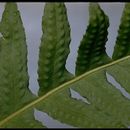en
names in breadcrumbs


Polypodium californicum is a species of fern known by the common name California polypody.
It is native to Baja California and California, where it grows along the coastline as well as in moist spots in coastal foothills and mountain ranges in the southern part of its distribution.
This polypody anchors with a scaly rhizome. It produces oval to triangular leaves up to 70 centimetres (28 in) in length and 20 centimetres (7.9 in) in width. Each leaf is made up of many dull-pointed lance-shaped segments which may be thin or firm or somewhat fleshy, and have lightly serrated edges. The underside of each leaf segment is lined with a double row of flattened or sunken sori, which contain the spores.
Polypodium californicum is a species of fern known by the common name California polypody.
It is native to Baja California and California, where it grows along the coastline as well as in moist spots in coastal foothills and mountain ranges in the southern part of its distribution.
El polipodio de California (Polypodium californicum) es una especie de helecho de la familia Polypodiaceae.
Este helecho epífito perennifolio es nativo de California y crece en camas de roca en suelo rico en humus. Las frondes, que brotan de unos rizomas rastreros bajos, alcanzan alturas de 30 cm y están profundamente hendidas. Este helecho se cultiva en grietas rocosas llenas de humus y agua durante las épocas secas.
Polypodium californicum fue descrita por Georg Friedrich Kaulfuss y publicado en Enumeratio Filicum 102. 1824.[1][2]
El polipodio de California (Polypodium californicum) es una especie de helecho de la familia Polypodiaceae.
Polypodium californicum là một loài thực vật có mạch trong họ Polypodiaceae. Loài này được Kaulf. miêu tả khoa học đầu tiên năm 1824.[1]
Polypodium californicum là một loài thực vật có mạch trong họ Polypodiaceae. Loài này được Kaulf. miêu tả khoa học đầu tiên năm 1824.